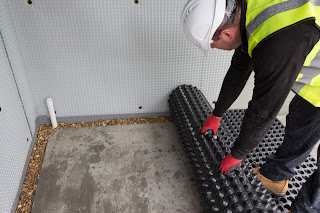Basement Waterproofing Erie
These are usually build of reinforced concrete where the walls and floor are tied together with reinforcement and the whole structure is designed to be suitable thick and strong and water tight without the need for additional waterproofing. However, unfortunately, an engineers' or architects theoretical drawings and calculations are not always Basement Waterproofing Erie translated on site perfectly and a slight defect in a water-bar (the plastic strip that seals joints in the structure) a poorly compacted bit of concrete at the bottom of a pour, perhaps a little too much water in the mix resulting in shrinkage cracking can all lead to leaks where there should be none!
MANY MODERN BASEMENT STRUCTURES FALL INTO THE TYPE B CATEGORY - we will only be concerned with the 'failed type B's as the successes obviously do not need waterproofing!
Type C. Many civil engineering structures involving deep basements are constructed in the drained cavity format. Next time you are in a basement car-park of a big shopping center, maybe two or storyes down and you are looking at a nice neat DRY concrete block wall, perhaps you will wonder why it is so dry so far below ground - well perhaps not, - but if your single story domestic basement is flooded then perhaps you WILL wonder how they achieve this.
Very simply, the block-work wall that you are looking at is separated by a CAVITY between it and the earth retaining walls beyond. The earth retaining wall is often very wet, maybe even running with water ingress but the inner wall is kept dry by virtue of the 'drained cavity' in-between. The water from the cavity has to be drained somewhere and it is usually drained into a sump chamber from where it is pumped out.
Whilst is is rare for a domestic property to be constructed of a masonry or concrete drained cavity wall a 'miniature' drained cavity is often created by the application of a membrane to the earth retaining wall, thus creating a cavity between the retaining wall and the membrane itself. Thus a Type A masonry structure can often be converted to a Type C structure by the application of such a membrane.
But this leads us on to the waterproofing.....
PART 2 METHODS OF WATERPROOFING.
Towards the end of the last section I was describing how the 'structure' and the 'waterproofing' in a drained cavity situation are integrally linked. If the structure has a drained cavity then the drained cavity is part of the structure but is also an integral part of the waterproofing. The same is true of a tanked Type A structure where the structure is just as important as the water-proofing as the former has to hold the latter in place. This is crucially important point to understand, failure to appreciate how the structure and the waterproofing work together and depend on each other is a common cause of failure of waterproofing systems.
Waterproofing a Type A Structure
Basically there are TWO distinct approaches:-




Comments
Post a Comment